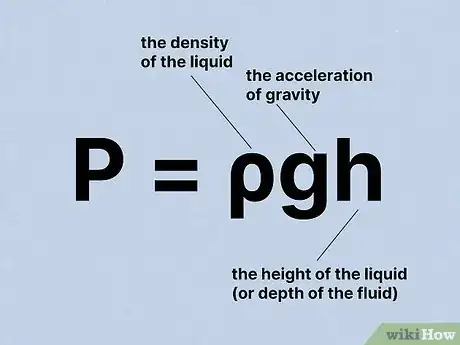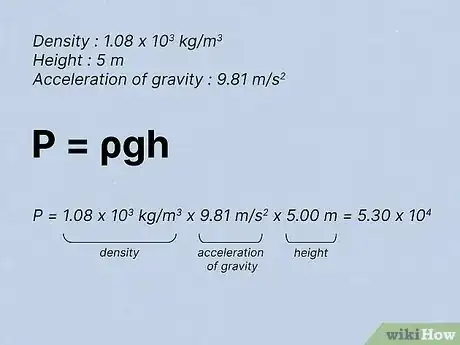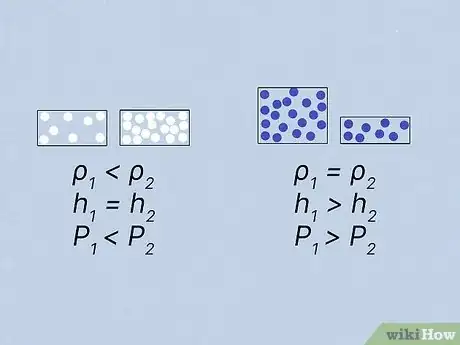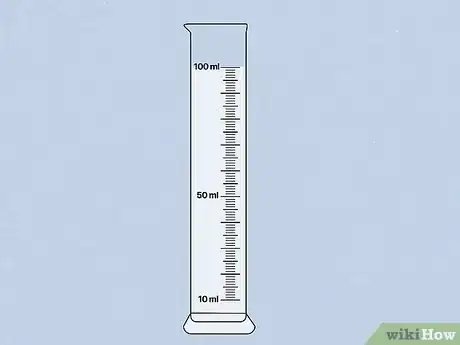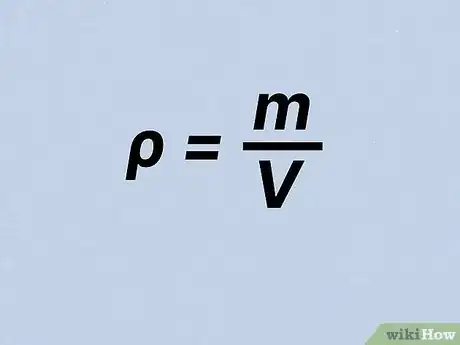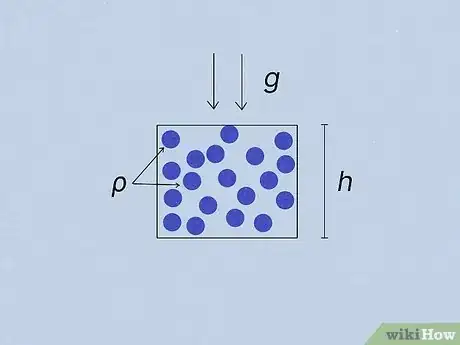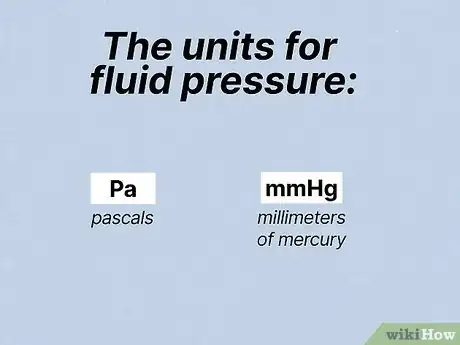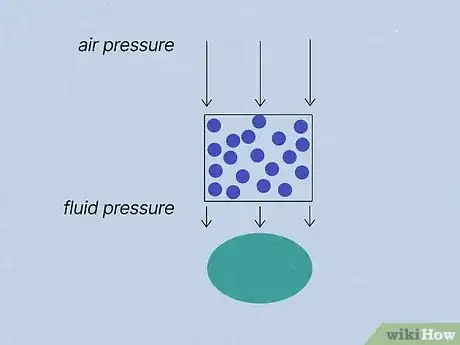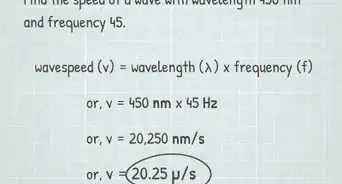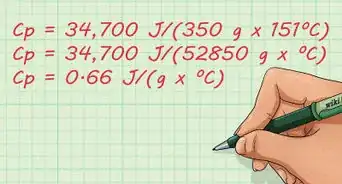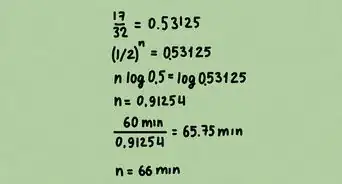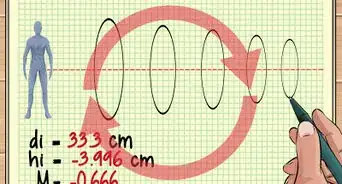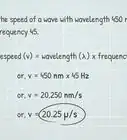This article was co-authored by Meredith Juncker, PhD. Meredith Juncker is a PhD candidate in Biochemistry and Molecular Biology at Louisiana State University Health Sciences Center. Her studies are focused on proteins and neurodegenerative diseases.
There are 7 references cited in this article, which can be found at the bottom of the page.
This article has been viewed 139,684 times.
When a fluid is at rest, it exerts a force perpendicular to any surface in contact with it. This force, which is due to the continuous, random motion of molecules, is known as fluid pressure. Knowing the fluid pressure is essential to mechanical and hydraulic systems that use fluids move pistons and other parts. It is usually measured in Pascals (Pa), where one Pascal is equal to one Newton per square meter (N/m2). Fluid pressure is independent of the mass of the fluid, but can be calculated with the density and height of the fluid.
Steps
Calculating Fluid Pressure
-
1Set up the equation. The equation for fluid pressure is independent of the mass or volume of the liquid. Instead, fluid pressure is the product of the density of the liquid, the height of the liquid above the object, and gravity. Since gravity and liquid densities are fixed (for the most part), the height of the liquid is the largest variable in the equation.[1]
- The equation reads as Pfluid = ρgh, where ρ is the density of the liquid, g is the acceleration of gravity, and h is the height of the liquid (or depth of the fluid).
-
2Multiply the variables. To solve the equation, you take the product of the three variables. You can use a calculator, or do the calculations on your own. There are also online calculators that will do this calculation for you.[2]
- For example, if you had a fluid that with a density of (1.08 x 103 kg/m3) and was 5.00 m high, you would multiply (1.08 x 103 kg/m3) x 9.81 m/s2 (acceleration of gravity on Earth) x 5.00 m. In this case, you would get the answer of 5.30 x 104.
Advertisement -
3Analyze your results. Make sure that your results add up logically. You should not get a reading for negative fluid pressure. You also should compare different measurements to see if they follow the expected trends. For example, more dense liquids will exert more pressure at the same height. The same liquid will exert more pressure when the height is higher.[3]
- Since water is more dense than oil, you can expect water to exert more fluid pressure than oil at the same height.
Finding the Density of your Liquid
-
1Measure the volume of your liquid. Pour 100 mL of liquid into a pre-weighed graduated cylinder. Make sure that your measurement is correct, and then write the volume down as 100 mL. You can write in a lab journal or notebook.[4]
-
2Weigh the liquid. Put the sample of liquid on a scale. Measure the mass of 100 mL of your liquid. You can tare the scale (zero it out) with the empty graduated cylinder on it before adding the liquid, or subtract the weight of the graduated cylinder from the total weight to obtain the mass of your liquid.[5]
- The measurement shown on the scale is the total mass of the liquid and the cylinder.
-
3Calculate the liquid’s density. Density is equal to the mass of the liquid divided by the volume of the liquid. In this case, you have measured both. You will simply divide the mass by 100 mL.[6]
- For example, if your liquid had a mass of 125 g, you would divide that by 100 mL. Your resulting answer would be 1.25 g/mL. However, make sure to pay close attention to the desired units of measurement. You may need to find the gallons per Liter (g/L) instead.
Understanding the Concepts
-
1Consider the meaning of each variable. The density of the liquid is significant because it tells you how much mass your liquid has per unit of volume. Gravity then exerts a force on that mass to pull it down. Finally, the height of the liquid tells you how much liquid is above the object experiencing the pressure.[7]
-
2Study the units involved. The units for fluid pressure are pascals or sometimes millimeters of mercury (mmHg). The pascal is an S.I. unit for pressure. The mmHg unit (and similar units that denote a height of some liquid) comes from the dependency of pressure on height.[8]
-
3See fluid pressure as one force acting on an object. The force that is exerted on some object by fluid pressure is only one force. There could many forces acting on the same object. For example, air pressure and fluid pressure are often added together to obtain a “total pressure” acting on some object.[9]
-
4Apply fluid pressure concepts. Once you have calculated fluid pressure for a liquid or set of liquids, you can use them for varying applications. For example, understanding the fluid pressure of water would be important to building a water tower that can hold water at a certain height. This is also important for use in mercury thermometers, or other systems that use liquids as measurements.[10]
Expert Q&A
Did you know you can get expert answers for this article?
Unlock expert answers by supporting wikiHow
-
QuestionWhat is the pressure due to water at a depth of 7.50 km below sea level?
 Meredith Juncker, PhDMeredith Juncker is a PhD candidate in Biochemistry and Molecular Biology at Louisiana State University Health Sciences Center. Her studies are focused on proteins and neurodegenerative diseases.
Meredith Juncker, PhDMeredith Juncker is a PhD candidate in Biochemistry and Molecular Biology at Louisiana State University Health Sciences Center. Her studies are focused on proteins and neurodegenerative diseases.
Scientific Researcher
-
QuestionHow do I calculate fluid pressure water in flowing rivers?
 Community AnswerP= Density * Gravity * Height. Multiply the density by the gravitational force and then multiply by the height.
Community AnswerP= Density * Gravity * Height. Multiply the density by the gravitational force and then multiply by the height. -
QuestionAre air- and water-pressure gauges different?
 Community AnswerYes, they are different. Air pressure gauges use a Bourdon tube, while water pressure gauges use a media for measurement.
Community AnswerYes, they are different. Air pressure gauges use a Bourdon tube, while water pressure gauges use a media for measurement.
References
- ↑ https://www.grc.nasa.gov/www/k-12/WindTunnel/Activities/fluid_pressure.html
- ↑ https://www.grc.nasa.gov/www/k-12/WindTunnel/Activities/fluid_pressure.html
- ↑ https://www.khanacademy.org/science/physics/fluids/density-and-pressure/a/pressure-article
- ↑ https://sciencing.com/measure-density-liquids-5815427.html
- ↑ https://chem.libretexts.org/Ancillary_Materials/Laboratory_Experiments/Wet_Lab_Experiments/General_Chemistry_Labs/Online_Chemistry_Lab_Manual/Chem_10_Experiments/02%3A_The_Density_of_Liquids_and_Solids_(Experiment)
- ↑ https://www.omnicalculator.com/physics/density
- ↑ https://www.khanacademy.org/science/physics/fluids/density-and-pressure/a/pressure-article
- ↑ http://www.edinformatics.com/math_science/hydrostatic_pressure.htm
- ↑ http://www.edinformatics.com/math_science/hydrostatic_pressure.htm
About This Article
To calculate fluid pressure, use the formula p × g × h = fluid pressure, where p is the density of the liquid, g is the acceleration of gravity, and h is the height of the fluid. Multiply the variables and take the product of the three to solve the equation. Use a calculator, do the calculations on your own, or look online for calculators that will do them for you. When you get your results, make sure they add up logically. For example, you should not get a reading for a negative fluid pressure. To learn how to find the density of your liquid from our Scientist co-author, keep reading!
